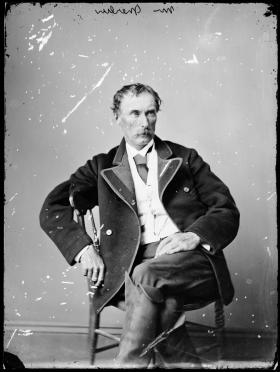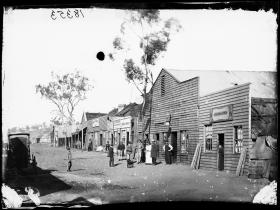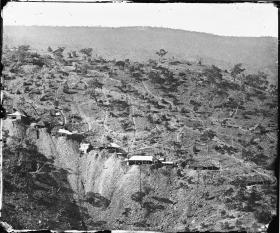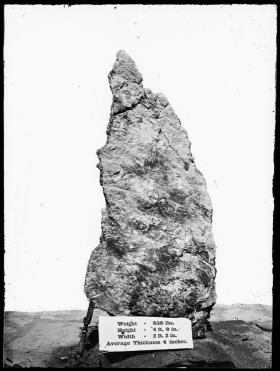In 1951 one of Australia’s most significant collections of nineteenth century photographs was found in a garden shed in Chatswood, Sydney.
Most of the negatives were taken between 1872 and 1876 and, although owned by Holtermann, the bulk of them were photographed by Henry Beaufoy Merlin and Charles Bayliss.
It was Merlin, the founder of the American and Australasian Photographic Company, who took most of the earlier landscape views and who, over an incredible ten years between 1863 and 1873, transformed himself from a theatrical showman into a landscape photographer, acknowledged by his contemporaries as one of the most important in Australia.
Henry was the son of Frederik and Ann Harriett Merlin (Murlin) and was probably born in London in 1830. After the death of his father in 1845, he came to Sydney with his mother in December 1848.
In August 1852 Freeman’s Journal announced the opening of the Royal Marionette Theatre, in the saloon of the Royal Hotel, Sydney. These shows, popular in London, were a mixture of technology, farce and music which incorporated live actors, puppets, panoramas, magic lantern shows and song. In May 1853, a Henry Murlin took out a licence to establish a Marionette theatre in the old Olympic Circus building in Castlereagh Street, Sydney. A month later Murlin went on the road with the ‘burlesque theatre’ and held successful shows, which included a performance of Bombastes Furioso by William Rhodes.
Merlin then travelled to Maitland where he set up a theatre in High Street, Maitland in 1856 and started referring to himself Henry B. Muriel. The Following year, after the Maitland theatre burned to the ground, Merlin moved to Newcastle and worked as manager, actor and painter of scenery for the Newcastle Theatre.
In June 1858, he opened An Indian panorama a la Mont Blanc at the Lyceum Theatre in Sydney. The performance involved a series of scrolling panoramic scenes and projections over which a narrator would recount tales, offer scientific snippets, sing songs and offer humorous vignettes.
In 1865 Merlin moved away from theatrical presentations and in January 1865, under the name of H. Merlin, he opened the ‘Kyneton Photographic Studio’ in Piper Street, Kyneton, a small town in northern Victoria.
Merlin began advertising his services, taking photographs of public buildings and private residences, ‘at moderate terms and on the shortest notice’. By February 1869 his contemporaries were touting him as a successful travelling landscape photographer and on 21 June 1869, he formed the American and Australasian [sometimes recorded as Australian] Photographic Company (AAPC).
‘Mr. Merlin has armed himself with a beautiful frame of pictures to use as his credentials on making his first professional tour through this district and it is only common justice to say of these that they are pictures in the artistic sense of the word. The negatives he has taken have been forwarded to Melbourne to be printed, and will then be sent up for sale.’
Within a few short years the AAPC became a large and complicated business with Merlin at its centre. The large format camera used to take panoramic views of the city, the high-end finish of their painted photographs, the area covered by their workers and the scale of production pushed both the boundaries of the technology and the methodology traditionally used by photo studios in Australia.
On 27 November, Merlin left Sydney on the steamship Governor Blackall as a part of the Australian Solar Eclipse Expedition bound for Northern Queensland. Accompanying him on board were a ‘who’s who’ of Australia’s natural historians and scientists all of whom were travelling to Cape Sidmouth to view the solar eclipse on 12 December. Unfortunately, after they had set up their instruments on Eclipse Island the day proved too overcast for Merlin to take any successful photographs.
By the beginning of 1872 the America and Australasian Photographic Company was one of the best-known photography businesses in New South Wales. But on 5 February Beaufoy Merlin resigned as manager, packed up his camera and equipment and headed off to the newly discovered goldfields at Hill End, Tambaroora and Gulgong near Bathurst, New South Wales.
Australian historians are remarkably lucky that one of Australia’s best-known landscape photographers, whose methodology was to photograph every building in a town, should arrive at the height of the gold boom with his cameras and equipment. For his part, Merlin seemed to have been captivated by the hustle and bustle of the towns, as well as the characters he met. He stayed in Hill End and documented the town and surrounding area for most of 1872 and returned off-and-on in 1873 to add to the collection.
While many of Merlin’s photographs were taken of the buildings and streets others were taken in the goldfields themselves. One of these photos, depicting the mines at Hawkins Hill, was reproduced in the Town and Country Journal on 18 May 1872. The mines in this image were among the most productive on the goldfields and one of these, the Star of Hope Gold Mining Company, was producing enough to make all its shareholders wealthy. One of the main beneficiaries was the manager Bernard Holtermann, who also owned the building rented by the AAPC in Hill End. It is not clear how early the friendship began, but clearly Merlin and Holtermann recognised in each other a like-minded soul or at least new business opportunities.
When the largest piece of reef-gold in the world was discovered in the Star of Hope mine on 19 October 1872, Holtermann approached Merlin to photograph the nugget before it was sent to the crusher.
The gold from the Star of Hope mine made Holtermann a very wealthy man and, by the end of December 1872, he left Hill End for his new home on the North Shore of Sydney. It was around this time that Merlin seems to have inspired Holtermann to start a new project. On 1 January 1873 several advertisements appeared in papers across the country describing a new and ambitious scheme to promote Australia to the world:
‘Holtermann’s Intercolonial Exposition of the Australian Colonies. … The undersigned, in directing public attention to the above outline of a projected display of the country’s industrial resources, cannot lose the opportunity of bearing testimony to the liberal spirit in which Mr. Holtermann has entered into this undertaking.’
For Merlin, 1873 was also shaping up well. As with many of his previous enterprises he had a partner and this time it was a man of immense wealth who, like himself, was hard working and entrepreneurial. Demonstrating the wealth of opportunities in Australia appears to have been the main object of the exposition. And Merlin’s substantial role was outlined in The Queenslander:
‘Mr. Holtermann has entered into an arrangement with Mr. Beaufoy Merlin (whose great fame as a landscape photographer is generally acknowledged), by which the latter gentleman is to take panoramas and views of all the towns and gold-fields in the colonies, in order to form a gallery which will give those at a distance a vivid and life-like representation of our homes and cities. The views taken by Merlin will be presented to the public in the form of magnificent transparent pictures - an invention in photography, of which Mr. Merlin possesses the secret. There will be also albums of each town and gold-field, containing statistical information and other valuable matter.’
In September 1873 Merlin died after a short illness and it was his one-time assistant Bayliss who took over from Merlin to become Holtermann’s primary photographer.
![Great Varieties Hall, tent theatre, Clarke Street run by William B. Gill and Captain Gus Pierce [i.e. Augustus Baker Peirce], Hill End](/sites/default/files/styles/banner/public/a2822906h.jpg?itok=_Ydyb_pA)

![[Album of photographs of Sydney & country New South Wales], ca. 1871 / American & Australasian Photographic Company](/sites/default/files/styles/max_width_280/public/a5743031h.jpg?itok=rSihuTWo)
![Great Varieties Hall, tent theatre, Clarke Street run by William B. Gill and Captain Gus Pierce [i.e. Augustus Baker Peirce], Hill End](/sites/default/files/styles/max_width_280/public/a2822906h.jpg?itok=1xbs7bT_)


